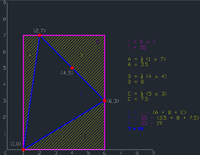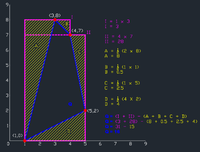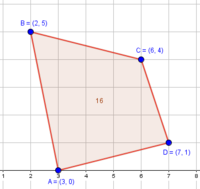You are using an out of date browser. It may not display this or other websites correctly.
You should upgrade or use an alternative browser.
You should upgrade or use an alternative browser.
Polygon definition
- Thread starter That_Man
- Start date
Dr.Peterson
Elite Member
- Joined
- Nov 12, 2017
- Messages
- 16,873
The definition here includes "with no three successive points collinear".
On the other hand, your triangle can be considered a degenerate quadrilateral, for some purposes. For example, in topology it doesn't matter, and many formulas for quadrilaterals still work in this case. Other theorems, however, would fail if you allowed this.
Why do you want to call it a quadrilateral? What will you do differently whether we say yes or no?
On the other hand, your triangle can be considered a degenerate quadrilateral, for some purposes. For example, in topology it doesn't matter, and many formulas for quadrilaterals still work in this case. Other theorems, however, would fail if you allowed this.
Why do you want to call it a quadrilateral? What will you do differently whether we say yes or no?
I had to find a quadrilateral using the digits 0-9 no more than 1 time each in the coordinates, with an area = 16. I stopped here because the area was good, but when I lined up the points, it became clear that my quadrilateral was actually a triangle :/
This is for my son's 7th grade math homework, and the problem seemed a bit hard to solve using 7th grade skills--he couldn't do it, in other words. I was intrigued, though, so I broke out AutoCAD and graphed some points. I guess I'll keep looking for a solution.
This is for my son's 7th grade math homework, and the problem seemed a bit hard to solve using 7th grade skills--he couldn't do it, in other words. I was intrigued, though, so I broke out AutoCAD and graphed some points. I guess I'll keep looking for a solution.
Dr.Peterson
Elite Member
- Joined
- Nov 12, 2017
- Messages
- 16,873
That does sound challenging. But clearly they would want a traditional definition, so your triangle is out.
I'm going to give it a try, and see if I can find an elementary approach that works; but it's probably meant to give practice in (a) organized searching, and (b) repeated application of whatever method they have learned to find areas given coordinates. Do you know what methods have been taught in class?
EDIT: I played with GeoGebra and found a solution fairly quickly. I don't yet see a reasonable way to do it manually.
I'm going to give it a try, and see if I can find an elementary approach that works; but it's probably meant to give practice in (a) organized searching, and (b) repeated application of whatever method they have learned to find areas given coordinates. Do you know what methods have been taught in class?
EDIT: I played with GeoGebra and found a solution fairly quickly. I don't yet see a reasonable way to do it manually.
Last edited:
This is from a remote education packet, since we're all shelter in place, and there's no link or reference how they might solve it with 7th grade skills. The most rudimentary way I could think of was with the rectangles and triangles method I'm showing. We did it on paper a few times, and the process was time consuming, and I had to stop before my son quit school forever and joined the circus.
Dr.Peterson
Elite Member
- Joined
- Nov 12, 2017
- Messages
- 16,873
I think a somewhat reasonable approach can be to start with a 4x4 square and move two vertices at a time, trying to keep the same area (or close) while making the coordinates different. It will take some close attention to how a move changes the area; at some point you would be just sliding the whole figure to fix coordinates, without changing its shape. This may not take too much calculation.
But in part it looks like a challenge for those who like challenges, and mere busywork for those who are less willing to like math. I hope it is presented as a puzzle, not as something everyone has to do. After a while, if you're looking for tricks rather than just trying the same calculations on one random shape after another, it does actually become almost fun ...
But in part it looks like a challenge for those who like challenges, and mere busywork for those who are less willing to like math. I hope it is presented as a puzzle, not as something everyone has to do. After a while, if you're looking for tricks rather than just trying the same calculations on one random shape after another, it does actually become almost fun ...
Dr.Peterson
Elite Member
- Joined
- Nov 12, 2017
- Messages
- 16,873
Your solution is not congruent to mine, which is interesting. (Mine, which looks more like the 4x4 square I started with, can also be shifted to several alternative locations, making "different" solutions, by just adding 1 to every coordinate.)
Another way to find the area is the "shoelace formula", found for example here, which uses the coordinates directly. That doesn't necessarily make it any easier to find an answer, but somewhat simplifies the work of checking. I was wondering whether the class might have been taught that or some other less thought-intensive method for finding areas.
Another way to find the area is the "shoelace formula", found for example here, which uses the coordinates directly. That doesn't necessarily make it any easier to find an answer, but somewhat simplifies the work of checking. I was wondering whether the class might have been taught that or some other less thought-intensive method for finding areas.
Dr.Peterson
Elite Member
- Joined
- Nov 12, 2017
- Messages
- 16,873



